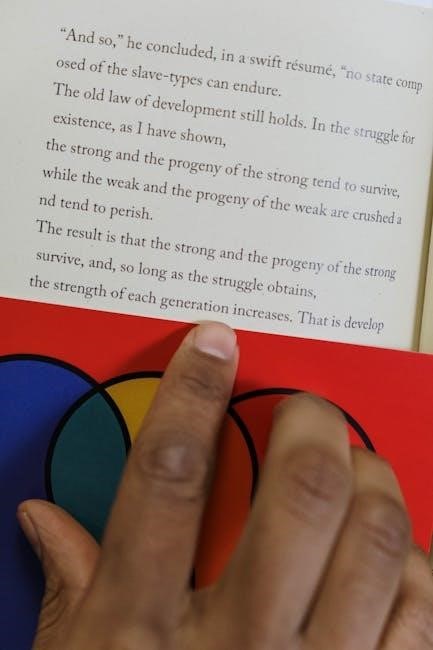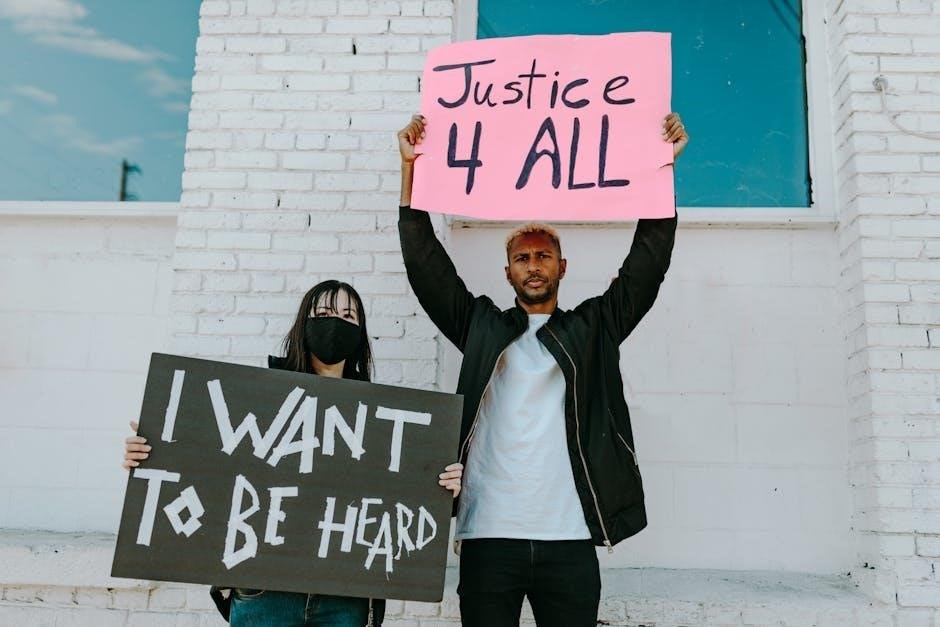Dr․ Martin Luther King Jr․ was a pivotal figure in the civil rights movement, advocating for equality through nonviolent protest․ Reading comprehension resources, such as PDFs and worksheets, help students engage with his legacy, fostering critical thinking and empathy․ These materials often include key vocabulary and historical context, making his story accessible for learners of all levels․ By studying MLK Jr․’s life and speeches, students gain a deeper understanding of his impact on social justice and modern society․ Interactive tools enhance learning, ensuring his message remains relevant for future generations․
1․1 Overview of Martin Luther King Jr․’s Life
Dr․ Martin Luther King Jr․ was born on January 15, 1929, in Atlanta, Georgia․ He became a prominent leader in the civil rights movement, advocating for racial equality and social justice through nonviolent protest․ King earned a doctoral degree in theology and led significant events like the Montgomery Bus Boycott and the March on Washington․ His iconic “I Have a Dream” speech remains a cornerstone of American history․ Tragically, he was assassinated in Memphis, Tennessee, on April 4, 1968․ King’s legacy endures as a symbol of courage and determination, inspiring generations to fight for equality․ Reading comprehension resources, such as PDFs, provide students with insights into his life and contributions, fostering a deeper understanding of his impact on society․
1․2 Importance of Reading Comprehension in Understanding MLK Jr․’s Legacy
Reading comprehension is essential for understanding the depth of Martin Luther King Jr․’s legacy, as it enables students to critically analyze his speeches, writings, and historical context․ Through reading comprehension exercises, learners gain insights into King’s vision of equality and justice, fostering empathy and social awareness․ These skills help students decode complex vocabulary and interpret the significance of key events, such as the “I Have a Dream” speech․ By engaging with reading materials, including PDFs and interactive tools, students develop a deeper connection to King’s message and its relevance today․ This understanding not only enhances academic skills but also inspires a commitment to social change, ensuring King’s legacy continues to resonate across generations․

Biography and Historical Context
Dr․ Martin Luther King Jr․, born in 1929, was a prominent leader in the civil rights movement, advocating for racial equality through nonviolent protest during the 1950s and 1960s․
2․1 Early Life and Education of Martin Luther King Jr․
Martin Luther King Jr․ was born on January 15, 1929, in Atlanta, Georgia․ His father, Martin Luther King Sr․, was a Baptist minister, and his mother, Alberta Williams King, was a schoolteacher․ King excelled academically, attending Morehouse College at 15, where he studied sociology․ He later earned a Bachelor of Divinity degree from Crozer Theological Seminary and a Ph․D․ in systematic theology from Boston University․ King’s education shaped his commitment to social justice and nonviolent resistance․ At 25, he became pastor of Dexter Avenue Baptist Church in Montgomery, Alabama, beginning his journey as a civil rights leader․ His early life and education laid the foundation for his role in the movement․

2․2 Key Events in MLK Jr․’s Civil Rights Movement
Martin Luther King Jr․ played a central role in several pivotal events during the civil rights movement․ The Montgomery Bus Boycott (1955-1956), sparked by Rosa Parks’ refusal to give up her seat, demonstrated the power of nonviolent protest․ King also led the 1963 Birmingham Campaign, where he wrote his famous “Letter from a Birmingham Jail,” advocating for peaceful civil disobedience․ The March on Washington in 1963 culminated in his iconic “I Have a Dream” speech, calling for racial equality․ Additionally, the Selma to Montgomery Marches in 1965 highlighted voting rights issues, leading to the passage of the Voting Rights Act․ These events showcased King’s leadership and commitment to justice, inspiring nationwide change․

Reading Comprehension Resources

Martin Luther King Jr․ reading comprehension resources include PDFs, worksheets, and interactive materials․ These tools cover key events, speeches, and his impact on civil rights, fostering educational engagement․
3․1 Types of Reading Comprehension Exercises Available
Various types of reading comprehension exercises are available to engage students with Martin Luther King Jr․’s life and legacy․ These include multiple-choice questions, true/false statements, fill-in-the-blank activities, and short-answer prompts․ Additionally, essay questions and critical thinking exercises encourage deeper analysis of MLK Jr․’s speeches and writings․ Interactive PDFs offer digital tools for remote learning, allowing students to complete exercises electronically․ Many resources also incorporate key vocabulary practice, ensuring students understand essential terms related to MLK Jr․’s life and the civil rights movement․ These exercises cater to different learning styles and skill levels, providing educators with diverse options to enhance comprehension and retention․
3․2 Key Vocabulary Associated with MLK Jr․ in Reading Materials
Reading comprehension materials on Martin Luther King Jr․ often include key vocabulary that reflects his life and legacy․ Terms such as “civil rights,” “nonviolent protest,” “segregation,” and “equality” are frequently highlighted․ Additionally, words like “leadership,” “advocacy,” and “justice” are central to understanding his role in the movement․ Historical terms like “Montgomery Bus Boycott” and “March on Washington” are also emphasized․ These vocabulary words are usually contextualized within the readings, helping students decode and comprehend their meanings․ Interactive PDFs often feature exercises that focus on these terms, ensuring students grasp their significance in MLK Jr․’s journey and the broader civil rights context․ This vocabulary enhances both reading proficiency and historical understanding․
3․3 Structure of MLK Jr․ Reading Comprehension Worksheets
MLK Jr․ reading comprehension worksheets typically follow a structured format to enhance learning․ They often begin with a passage about MLK Jr․’s life, key events, or speeches․ Following the text, multiple-choice questions, true/false statements, and fill-in-the-blank exercises are included to assess understanding․ Some worksheets feature short-answer sections for more in-depth responses, while others incorporate essay prompts for critical thinking․ Interactive PDFs may include highlightable text and fillable fields for digital completion․ These structures cater to various learning styles, ensuring engagement and effective comprehension of MLK Jr․’s legacy․ The design promotes accessibility, making it suitable for both classroom and remote learning environments․
3․4 Benefits of Using Interactive PDFs for Remote Learning
Interactive PDFs offer numerous advantages for remote learning, particularly in teaching MLK Jr․’s legacy․ They allow students to engage with content dynamically, featuring clickable links, highlightable text, and fillable fields․ These tools enhance accessibility, enabling students to complete assignments electronically without requiring physical materials․ Teachers can easily distribute and collect work via email or learning platforms, streamlining the educational process․ Interactive PDFs also support self-paced learning, giving students flexibility to review content as needed․ Additionally, they reduce paper waste, promoting a more sustainable learning environment․ The ability to save progress ensures that students can work on tasks at their convenience, making remote education more efficient and effective for all participants․ This adaptability makes interactive PDFs invaluable for modern educational settings․

Key Speeches and Writings
Martin Luther King Jr․’s “I Have a Dream” speech and “Beyond Vietnam” address are central to reading comprehension resources․ These texts highlight his vision for equality and justice, providing students with rich material to analyze his rhetorical strategies and historical context․ Reading comprehension exercises focus on key vocabulary and themes, enabling learners to grasp the depth of his message․ These resources are essential for understanding MLK Jr․’s enduring impact on civil rights and social change, making his writings accessible and engaging for educational purposes․ His speeches remain cornerstone texts for exploring his legacy and continue to inspire new generations․ MLK Jr․’s words offer timeless lessons on courage, resilience, and the pursuit of equality․
4․1 Analysis of the “I Have a Dream” Speech
The “I Have a Dream” speech, delivered by Martin Luther King Jr․ in 1963, is a cornerstone of American civil rights history; Reading comprehension exercises focusing on this speech help students analyze its powerful rhetoric, key themes of equality and justice, and its historical context․ The speech’s repetitive phrases, such as “I have a dream,” emphasize King’s vision for a unified society․ PDF resources and worksheets often include questions that prompt learners to identify metaphors, understand the emotional appeal, and reflect on the speech’s enduring impact․ These materials also highlight King’s call to action, encouraging students to think critically about the ongoing struggle for civil rights․ By engaging with this speech, students gain a deeper understanding of its significance and relevance today․
4․2 Beyond Vietnam: Understanding MLK Jr․’s Expanded Vision
Martin Luther King Jr․’s “Beyond Vietnam” speech, delivered in 1967, marked a significant expansion of his advocacy, addressing issues beyond civil rights to include opposition to the Vietnam War․ Reading comprehension exercises on this speech highlight King’s critique of militarism, economic inequality, and moral hypocrisy․ He argued that true justice must encompass global peace and human rights, linking the struggles of African Americans to those of oppressed people worldwide․ Despite facing criticism, King’s vision emphasized the interconnectedness of social justice causes․ Educational resources, such as PDFs and worksheets, help students analyze the speech’s themes, rhetorical strategies, and historical context, fostering a deeper understanding of King’s evolving philosophy and its relevance to contemporary issues․

Educational Benefits of MLK Jr․ Reading Comprehension
Engaging with MLK Jr․ reading comprehension materials enhances critical thinking, fosters empathy, and builds vocabulary skills․ Interactive PDFs and worksheets promote a deeper understanding of his legacy, encouraging reflection on social justice and equality․ These resources are invaluable for developing analytical skills and inspiring students to explore historical and contemporary issues related to civil rights․ By integrating MLK Jr․’s story into curriculum, educators equip learners with tools to navigate complex societal challenges․ The combination of historical context and reading exercises ensures a well-rounded educational experience․
5․1 Enhancing Critical Thinking Skills Through MLK Jr․’s Biography
Reading comprehension exercises focused on Martin Luther King Jr․’s biography provide students with opportunities to analyze his decisions, actions, and their historical context․ By engaging with his life story, learners develop critical thinking skills as they evaluate the motivations behind his leadership in the civil rights movement․ These exercises often include questions that prompt students to reflect on the consequences of his actions and the broader societal impact․ Key vocabulary associated with MLK Jr․’s life, such as “nonviolent protest” and “civil rights,” enhances comprehension and encourages deeper analysis․ Structured worksheets and interactive PDFs further facilitate remote learning, ensuring students can independently explore and understand his legacy․ This approach not only strengthens analytical abilities but also fosters a connection to historical events that shaped modern society․

5․2 Developing Empathy and Social Awareness
Reading comprehension exercises about Martin Luther King Jr․ foster empathy by allowing students to connect with his experiences and the struggles of the civil rights movement․ Through analyzing his speeches and writings, learners gain insight into the emotional and social challenges faced by marginalized communities․ This engagement helps students develop a deeper understanding of social justice issues and promotes tolerance․ Interactive PDFs and worksheets often include reflection questions that encourage students to consider the perspectives of others․ By exploring MLK Jr․’s commitment to equality, young readers cultivate empathy and a heightened awareness of the importance of standing against discrimination․ These skills are essential for fostering a more compassionate and inclusive society․

Interactive and Digital Learning Tools
Interactive PDFs and digital worksheets provide engaging ways to explore MLK Jr․’s legacy․ These tools support remote learning, offering fillable fields and multimedia features to enhance student engagement and accessibility․
6․1 Features of Interactive PDFs for MLK Jr․ Reading Comprehension
Interactive PDFs for MLK Jr․ reading comprehension include fillable fields, clickable buttons, and embedded multimedia․ These features allow students to answer questions, highlight text, and interact with content dynamically․ PDFs often contain multiple-choice questions, true/false statements, and open-ended responses, catering to different learning styles․ They also include answer keys for self-assessment․ Some PDFs are designed with color-coded sections for visual learners, while others incorporate audio clips of MLK Jr․’s speeches․ These tools are compatible with both desktop and mobile devices, making them ideal for remote learning․ Interactive PDFs enhance engagement by providing immediate feedback and fostering a hands-on approach to learning about MLK Jr․’s life and legacy․
6․2 How Digital Tools Enhance Engagement in Learning
Digital tools significantly enhance engagement in learning by making educational content interactive and accessible․ Interactive PDFs and online platforms allow students to participate actively, fostering a deeper connection to MLK Jr․’s legacy․ Features such as clickable buttons and multimedia elements provide visual and auditory learning experiences, catering to diverse learning styles․ Real-time feedback and collaborative options encourage students to stay motivated and involved․ Digital tools also enable personalized learning, allowing students to progress at their own pace․ This approach not only improves retention but also prepares learners for the digital demands of modern education․ By integrating technology, MLK Jr․’s story becomes more relatable and impactful, inspiring the next generation to embrace his principles of equality and justice․

Historical Impact and Relevance
Dr․ Martin Luther King Jr․’s legacy profoundly shaped civil rights and social justice, inspiring modern movements․ Educational resources, like PDFs, ensure his vision remains relevant, teaching future generations about equality, empathy, and the power of peaceful protest, preserving his impact for years to come․
7․1 MLK Jr․’s Influence on Modern Civil Rights Movements
Dr․ Martin Luther King Jr․’s legacy continues to inspire modern civil rights movements, emphasizing nonviolent protest and equality․ His vision aligns with contemporary struggles for racial justice and voting rights․ Reading comprehension resources, such as PDFs, highlight his historical impact, educating students on how his methods and message remain relevant today․ These materials bridge the past and present, showing how King’s fight for equality influences ongoing efforts to address systemic injustice․ By studying his life and speeches, learners gain insights into the power of peaceful activism, fostering empathy and a commitment to social change․ His influence ensures that his dream of a more equitable society remains a guiding force for future generations․
7․2 The Role of Education in Preserving MLK Jr․’s Legacy
Education plays a vital role in preserving Martin Luther King Jr․’s legacy by ensuring his teachings and contributions are passed to future generations․ Reading comprehension resources, such as PDFs and worksheets, provide students with a deeper understanding of his life, speeches, and the civil rights movement․ These materials often include biographies, key speeches, and critical thinking exercises, fostering empathy and social awareness․ Interactive PDFs also enable remote learning, making educational access widespread․ By incorporating MLK Jr․’s story into curricula, educators highlight the importance of equality and nonviolent activism․ This educational focus ensures that his vision of a just society remains relevant and inspires ongoing efforts to address social injustices․ Through learning, his legacy endures, shaping a more informed and compassionate world․
8․1 Summary of MLK Jr․’s Significance and Educational Resources
Dr; Martin Luther King Jr․’s significance lies in his transformative role in the civil rights movement, advocating for equality and justice through nonviolent protest․ His legacy continues to inspire educators and students alike, with reading comprehension resources like PDFs and interactive worksheets playing a crucial role in sharing his story․ These educational tools not only enhance understanding of his historical impact but also foster critical thinking and empathy․ By incorporating key vocabulary and comprehension exercises, they make MLK Jr․’s vision accessible to learners of all ages․ Such resources ensure his message of unity and equality remains relevant, educating future generations about the power of peaceful activism and social change․
